 |
 |
 |
| |
HIV-Associated Peripheral Neuropathy in the HAART Era: Results from AIDS Clinical Trials Group (ACTG) Longitudinal Linked Randomized Trials (ALLRT) Protocol A5001
|
| |
| |
Reported by Jules Levin
CROI 2009 Feb 8-12 Montreal
Scott R. Evans1, David B. Clifford2, Huichao Chen1, Giovanni Schifitto3, Tzu-min Yeh1, Kunling Wu1, Ron Bosch1, Justin C. McArthur4, David M. Simpson5, Ronald J. Ellis6
1Harvard School of Public Health, Boston, MA, USA; 2Washington University, Saint Louis, Mo, USA; 3University of Rochester, Rochester, NY, USA; 4Johns Hopkins University, Baltimore, MD, USA; 5Mount Sinai School of Medicine, New York, NY, USA; 6University of California at San Diego, San Diego, CA, USA
"The prevalence of peripheral neuropathy and symptomatic peripheral neuropathy increases with time after ARV initiation in ARV-naïve patients despite increased virologic control and immune function, and the decline of d-drug use. Age and d-drug use are notable risk factors for PN and SPN."
AUTHOR CONCLUSIONS
Neuropathic signs persist despite improved immunologic function and viral control associated with combination ARVs.
Signs frequently occur without pain.
Age, d-drug use, PI use, year since initiation of anti-HIV therapy, IV drug use, HCV seropositivity, and baseline HIV-1 RNA are associated with PN and SPN.
Limitations of this study include its observational nature with the potential for informative drop-out/in, self-selection issues in ARV use (e.g., d-drug use), and that the observed association may not be causal.
ABSTRACT
Background: Peripheral neuropathy (PN) is the most frequent neurological complication in HIV infection. Symptoms including pain, numbness, and "pins and needles" sensation, affect quality of life, often require analgesic therapy and may influence the choice of antiretroviral (ARV) drugs. No FDA-approved therapy exists. While pre-HAART risk factors for PN included high HIV-1 RNA, low CD4, and neurotoxic ARV (d-drug) use, risk factors in the HAART era are not well delineated. Objectives of this study include estimating the prevalence of neuropathic signs and symptoms with ARV initiation in ARV-naïve patients and investigating prognostic factors in the HAART era.
Methods: Participants from the ACTG A5001 cohort that initiated HAART in randomized trials for ARV-naïve patients were annually administered a brief PN screen by trained site personnel, evaluating symptoms and signs of PN between January 2000 and June 2007. HIV-1 RNA, CD4, d-drug and PI use were concurrently collected longitudinally. PN was defined as at least mild loss of vibration sensation in both great toes bilaterally or absent or hypoactive ankle reflexes bilaterally relative to knees. Symptomatic PN (SPN) was defined as PN plus bilateral symptoms. Multivariate logistic generalized estimating equation regression models were used to estimate associations with PN and SPN while controlling for potential confounders.
Results:
2135 ARV-naïve participants (81% male, 44% white, 32% black, median age=39, median log HIV-1 RNA at HAART initiation=4.9) were analyzed.
d-drug use peaked at week 144 (25%) dropping to 10.9% at week 384.
The increasing prevalences of PN and SPN after HAART initiation are summarized below:
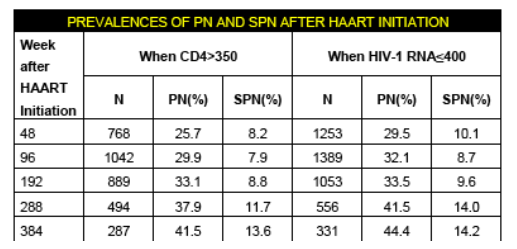
Notable factors associated with PN included: year since HAART-initiation (p<0.01, OR=1.09 for each additional year, 95% CI=(1.06, 1.12)), age (p<0.01, OR=1.89 for a 10 year increase, 95% CI=(1.72, 2.06)), and d-drug use (p=<0.01, OR=1.51, (1.30, 1.75)).
Conclusions: The prevalence of PN and SPN increases with time after ARV initiation in ARV-naïve patients despite increased virologic control and immune function, and the decline of d-drug use. Age and d-drug use are notable risk factors for PN and SPN.
BACKGROUND
Sensory neuropathies (SNs) are the most frequent neurological disorder associated with HIV infection and its treatment with ARVs.
There are two major types of HIV-associated peripheral SN, distal sensory polyneuropathy (DSP) and ARV toxic neuropathy (ATN) which affect approximately 30%-67% of patients with advanced HIV disease.
DSP is the most common SN in HIV infection. ATN is the most common toxicity of ARV therapy in Sub-Saharan Africa.
The most common symptom of HIV-SN is pain. Other symptoms include numbness, paresthesia, or burning sensation. Common signs include reduced or absent ankle reflexes with intact patellar reflexes, reduced or absent vibration sensation in the toes, and decreased pin and temperature sensation in a stocking/glove distribution.
No FDA approved therapies exist for HIV-associate SNs with treatment limited to symptomatic measures.
Higher plasma HIV-1 RNA levels and lower CD4+ cell counts before the initiation of ARV therapy appeared to increase the risk of DSP in the pre-HAART era. Prolonged exposure to HAART, protease inhibitor (PI) exposure, and lipid lowering drugs (statins and fibrates) have been suggested as risk factors for neuropathy in the HAART era.
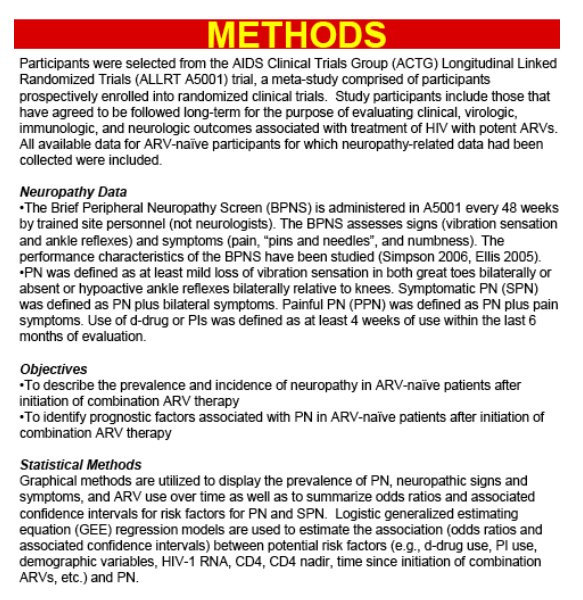
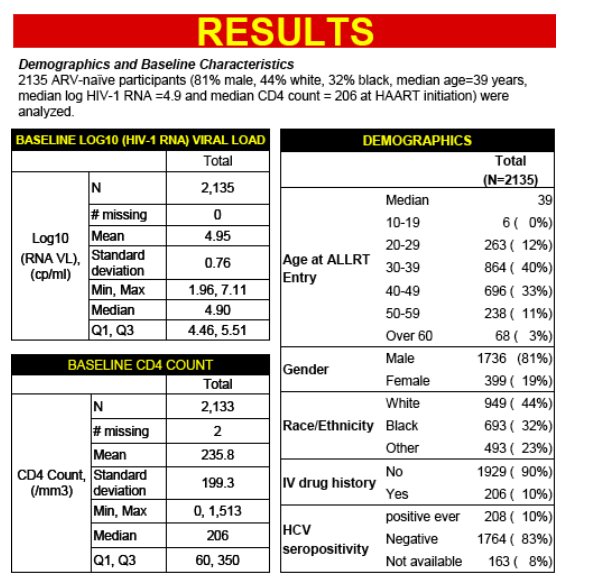
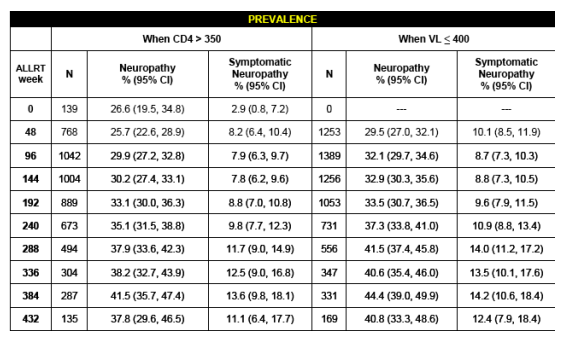
Risk Factors
Increased age, d-drug use, and higher baseline HIV-1 RNA are univariately associated with increased risk of PN and SPN.
Multivariate modeling suggests notable factors associated with PN include age (OR=1.89, 95% CI=(1.72, 2.06)), d-drug use (OR=1.51 95% CI=(1.30, 1.75)), and log10 baseline HIV-1 RNA (OR=1.13, 95% CI=(1.02, 1.26)). The multivariate model also included race, CD4 count, PI use, and years since HAART initiation. Multivariate modeling suggests notable factors associated with SPN include age (OR=1.89, 95% CI=(1.67, 2.13)), d-drug use (OR=1.84 95% CI=(1.49, 2.28)), and log10 baseline HIV-1 RNA (OR=1.35, 95% CI=(1.13, 1.62)). The multivariate model also included gender.
SORRY, the tables in this poster are not readable. But you can get the general sense from the lines in the graph that neuropathy persists over time.
Prevalence
Signs and symptoms of PN persist despite viral control and improved immune function with initiation of combination ARVs.
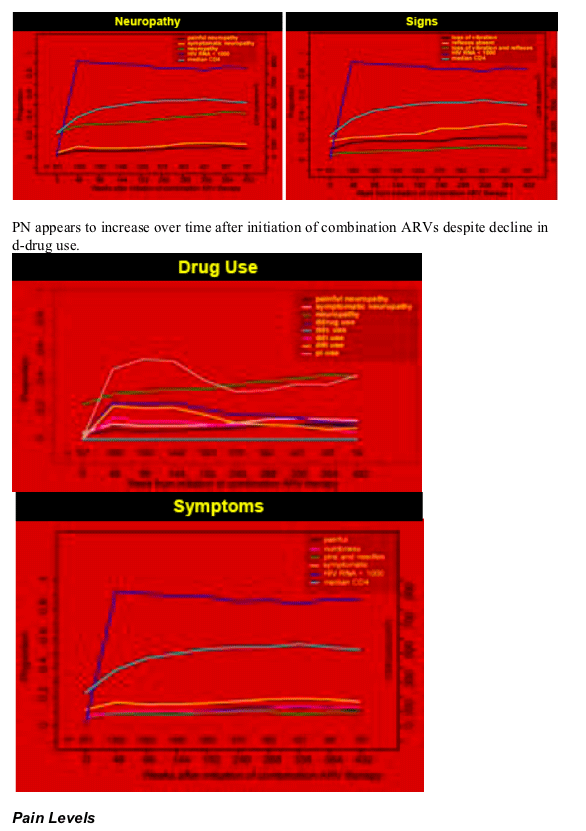
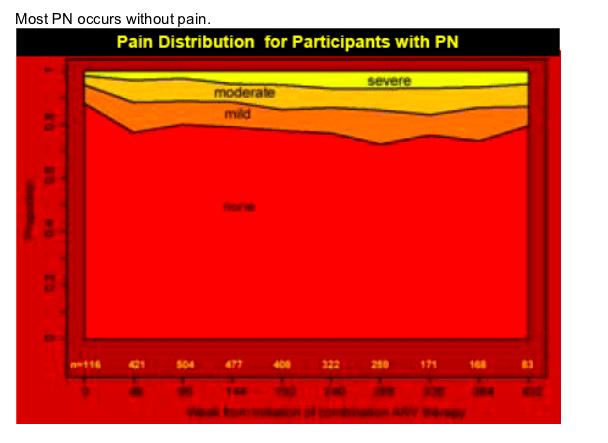
|
| |
|
 |
 |
|
|